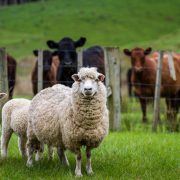Comparison of clinical cure rates from footrot and contagious ovine digital dermatitis using zinc sulphate foot bathing and topical oxytetracycline: A randomised trial
Comparison of clinical cure rates from footrot and contagious ovine digital dermatitis using zinc sulphate foot bathing and topical oxytetracycline: A randomised trial

Open access
In our edition of: Aug 2023
In our categories of: farm animals
our summary:
Jackson, A. et al. (2023) Comparison of clinical cure rates from footrot and contagious ovine digital dermatitis using zinc sulphate foot bathing and topical oxytetracycline: A randomised trial. Veterinary Record, e3116.
The aim of this randomised controlled trial was to establish, and compare, the clinical cure rates of interdigital dermatitis (ID), footrot (FR) and contagious ovine digital dermatitis (CODD) from using either an antibiotic oxytetracycline spray or a disinfectant zinc sulphate footbath.
The study, which was carried out in 2014, used a convenience sample of 75 eight month old, crossbred fattening lambs from a UK lowland mixed farm which had been identified by the farmer as lame.
The lambs were randomly allocated according to their ear tag number, with odd tag numbers allocated to treatment group A (n=38) and even tag numbers allocated to treatment group B (n=37). On days 0, 7, 14, 28 and 42 lambs were scored for locomotion and given a foot lesion score for ID, FR and CODD. All assessments were carried out by the same trained researcher for the duration of the study.
Lambs in group A stood for 15 minutes in a footbath containing a 10% zinc sulphate (Golden Hoof, Shep-Fair Products) solution at a depth of 10cm. Lambs in group B were treated with topical oxytetracycline (Alamycin Aerosol, Norbrook) with the spray applied to any foot lesion present over a period of five seconds. Lambs in both groups were moved to dry standing for 30 minutes after treatment. Both treatment protocols were carried out for five consecutive days.
At the start of the study (day 0) 66.67% (50/75) lambs were lame with no significant difference between treatment groups. Prevalence for ID, FR and CODD at sheep level was 88%, 62.67% and 22.33%, respectively; and 59.67%, 21% and 5.67% at foot level. There was no significant difference in the distribution of lesion scores between the two groups at sheep level. There was a significant difference between the two groups at foot level whereby some sheep had more than one foot affected by ID and FR.
At foot level the cure rates for ID on day 7 were 96.20% and 97.00% for zinc sulphate and oxytetracycline respectively. Clinical cure rates for ID declined in both groups over time to 53.16% for zinc sulphate and 61.00% oxytetracycline at day 42. For FR at day 7 cure rates were 100% for zinc sulphate and 95% for oxytetracycline, cure rates declined over time to 47.82% and 70% by day 42. For CODD at day 7 the cure rate for zinc sulphate was 90.09% and for oxytetracycline 83.33%, at day 42 this increased to 100% for the zinc sulphate group but remained at 83.33% for the oxytetracycline group. For lameness at day 7 50% of the zinc sulphate group and 59.09% of the oxytetracycline group were not lame this gradually increased to 71.43% and 68.18% by day 42. There was no significance difference between the lameness cure rates by treatment strategy.
Limitations of the study include the small sample size of 75 lambs, meaning the statistics was underpowered to demonstrate a difference between treatment groups. In addition, the sample was taken from a single cohort of lambs from one farm therefore these results may not be generalisable to other settings.
This study provides evidence that the use of either topical antibiotic oxytetracycline or a zinc sulphate footbath give a comparable cure rate for the treatment of interdigital dermatitis, footrot and contagious ovine digital dermatitis in lambs. These cure rates are comparable to those previously reported for systemically administered antibiotics therefore topical treatments have the potential to be considered as effective alternative treatments.
Further studies with larger sample sizes including different classes of sheep are required before the findings can be translated into recommendations for clinical practice.
The following may also be of interest:
Duncan, J.S. et al. (2021) Impact of research on contagious ovine digital dermatitis on the knowledge and practices of UK sheep farmers and veterinarians. Veterinary Record. 190 (1), p. e64. https://doi.org/10.1002/vetr.674
The October 2021 edition of inFOCUS contains a summary of this paper
Angell, J., Grove-White, D. and Duncan, J. (2018) A practical approach to dealing with contagious ovine digital dermatitis (CODD) on farms. Livestock, 23 (Sup5), pp. 15-18. https://doi.org/10.12968/live.2018.23.Sup5.15.
The December 2018 edition of inFOCUS contains a summary of this paper
Claiming CPD for reading inFOCUS articles
Reading and reflecting on articles can count towards your CPD, and we have a template to help you with the process.
Image copyright attribute: haiminhduong










Leave a Reply
Want to join the discussion?Feel free to contribute!